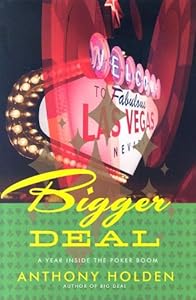What do you get when you cross a Big Deal with the library funding crisis? A Bigger Deal.
This thought (uttered while laughing all the way to the gallows) was prompted by a recent interview with the CEO of Springer, Derk Haank, in which he provocatively (deliberately provocatively?) announced that the serials crisis was over and that the Big Deal should get the credit for solving the problem.
Reading this, one could not help but imagine a chorus of voices saying, “How’s that again?” That the serials crisis is over is news to many, particularly librarians who are straining to meet the needs of their constituencies.
Clearly there are competing narratives here and, paraphrasing Nelson Mandela, where you stand depends on where you sit.
I am not going to rehash these competing narratives, as everyone involved with scholarly publishing has heard them many times. What does interest me is how things are likely to turn out. In my view, the rich will get richer, while the poor will either — in a Swiftian moment — get swallowed up by the rich or take the leap into author-pays open access publishing.
Let’s imagine a library with a serials budget that up until a few years ago seemed to be appropriate for its institution. By “appropriate” I don’t mean that the librarians could acquire everything they wanted (that would never be the case) but that faculty and students alike were not terribly distressed by the size and form of the collection. But then came the collapse of financial markets and the Great Recession, which resulted in serious cuts in library budgets.
Can the library still build an adequate collection?
While this is happening, the prices of Big Deals continue to rise, the prices of other materials rise, and new products are introduced to the marketplace, making demands on already shrinking budgets. Obviously some things cannot be purchased. While librarians will plead for lower prices, for the most part their cries are unheeded by the bigger publishers with the biggest of the Big Deals. This is because it is in the economic interest of the Big Deal purveyors to put the libraries under terrible pressure.
Sounds nasty and makes no sense? Nasty, yes, but logical. The library has to make cuts. What gets cut? The process to make cuts is complicated and as much art as science, but the basic outline is that items that are deemed less essential are cut first. Some of those less essential items, however, are tucked inside of Big Deals, where they can’t easily be touched without canceling the entire package. Since the Big Deals come from the biggest publishers and include some of the most essential material, the Big Deals are virtually invulnerable to cuts. This should not be a surprise, as this is one of the reasons the Big Deals were conceived of in the first place.
So let’s cut first the single-title publisher and then the publications of small publishers, including professional societies. Let’s trim everywhere we can. In the end, what is left standing are the very packages that many librarians believe caused the problem in the first place.
What happens to the journals that are cut — or, more to the point, what does the publisher of such journals believe is the best action to take before the cuts become drastic? One option is to cut a deal with a Big Deal publisher. Then the publication will continue to survive, tucked inside a large package; and its inclusion will be part of the rationale for annual price increases for the Big Deal. The Big Deal keeps getting bigger.
Or a publisher might choose to move to an author-pays open access model, something on the order of Hindawi or PLoS or the new services announced by Sage and Wiley. The author-pays model has the virtue of not taxing a library’s budget, though it nonetheless derives its revenue from the research community. And when a journal goes OA, it frees up some money — which libraries will then use to pay for the growing Big Deals.
Of course, creating a successful author-pays OA service is not a slam dunk, either.
In my discussions with librarians, I am generally not persuaded that they understand the nature and structure of the economic system in which they operate. They tend to think of the principal economic relationship as being between the library, which acts on behalf of its patrons, and publishers. This is incorrect. The key relationship is between the successful (and often large) publishers and the less successful. The question is how to grab more of a shrinking pie. The Big Deal is a means to that end. I am reminded of the tale of two men who are pursued by a bear. One man says, “Can you outrun a bear?” The other man says, “I don’t have to; I only have to outrun you.”
The challenge for smaller publishers and librarians alike is to find a way to improve their leverage in the marketplace. Author-pays OA may help some publishers, though it is noteworthy that many such services are now part of the programs of major organizations: Springer, AIP, Wiley, Nature, and Sage.
But before you can find a solution to a problem, you have to understand it first.
Discussion
12 Thoughts on "The Bigger Deal: One Scenario for How the Library Funding Crisis Will Play Out"
Joe, you’re so right – libraries need support to manage the commercial and technological aspects of their operations. I’ve proposed creation of a National Public Library Corporation (NPL) similar to PBS and NPR for this purpose. The NPL would allow librarians to be librarians and provide support around software development, supplier negotiations and fund-raising. Like the public broadcasters, it would be an addition to the library ecosystem rather than a replacement for individual outlets.
It’s a tough time to think about creating a new government agency, to be sure. It’s also tough to think about where the current course will take us … to a land with enfeebled academic libraries and few public libraries.
More ideas about the NPL are here: http://www.radicalpatron.com/category/npl/
Your suggestion that librarians do not understand the nature of the economic system in which they operate is interesting and will provoke. But surely the same is true of many of the other players – authors, readers, funders, and OA advocates. The challenge for smaller publishers seems to be that most of these don’t really care.
Richard – I think you make an important point about the other players not understanding the economic system either. Libraries (and librarians) don’t act purely on their own – they are pushed and prodded by the faculty they serve (and rightfully so). Things get more difficult when all the players don’t understand the game.
It is for the reason Joe states that a smaller journal publisher like Penn State Press (which had a dozen journals at the time I was its director) felt compelled to join Project Muse when it became open to other publishers in 2000. There was no future for a publisher with so few journals even though some were the best in their field, in the face of the massive economic power of the Big Deal. I’m not sure whether Joe considers Muse to be a Big Deal itself; it does offer options other than purchasing the entire collection. At any rate, the next interesting question becomes whether the principle of the Big Deal can be extended to the domain of books. Here, the biggest commercial publishers may not have an advantage over non-profits simply because the latter are known to have vigorous peer-review proceese4s in place for books whereas the former may or may not (and there is no transparency about the process here for commercial publishers as there is on the journals side). So, the book collections offered by non-profit publishers can be trusted by librarians to come with validation that may be lacking for commercially published book packages. That raises the further question whether, in dealing with this challenge, commercial publishers might try to package their books and journals together, using their top-rated journals as leverage to sell not only their lower-rated journals but also their books. Will librarians fall for that trap?
While I fully agree with most of Joe’s points, I’ve seen it argued lately that we should stop using the hoary term “serials crisis” to describe what is essentially a permanent market condition that librarians have yet to adjust their mindsets to. Any “crisis” which lasts 30 years and shows no signs of ever getting better no longer merits the term. Librarians (I am one) just need to get over the idea that some kind of collective action on their part will ever change the business practices of publishers or the attitudes of academic faculty and administrators.
And sorry, but OA is a sideshow. If it was going to change the world it would have done so by now.
David,
The “serials crisis” goes back to at least 1927 [1]. The solution to this crisis from the 20s through to the mid 90s was to develop tools for the librarian to make informed purchasing decisions.
In the last decade, we have clearly moved to a library-as-victim narrative. In constructing such a story, we also need an event, a perpetrator, and some form of way to enact justice. These have become the “publisher,” the “Big Deal,” and OA.
[1] Gross PLK, Gross EM. College Libraries and Chemical Education. Science 1927;66(1713):385-389. http://dx.doi.org/10.1126/science.66.1713.385
I would suggest that OA has developed a lot of credibility as an alternative model and gotten many people to start thinking seriously about all kinds of alternatives to the entrenched model. Major STM publishers have begun to adopt some aspects of it even. But my guess is that it will take some dramatic “tipping point” to make OA more than an interesting sideshow–e.g., the exit from the publishing business of some of the biggest players when they can no longer maintain the profit margins expected by their corporate owners.
The fact that major STM publishers have jumped may suggest only that they see dollar signs and an alternative (more likely additional) revenue stream, none of which suggests a reduction in the overall cost of publishing to the academic community.
That is an open question, certainly, but one possibility is that some of the gap would be filled by non-profit publishers that, historically, have charged lower prices than their commercial counterparts.
I seem to recall reading an article some 5 years ago that demonstrated quite convincingly that library budgets have not at all kept up with the growth of university and research budgets. So, while funding for research was still growing rapidly, library budgets were actually cut.
My conclusion at the time was, that publishers had a lot to answer for, but that pretty soon librarians should start getting their act together and ensure proper funding for proper library resources. And even though I only look superficially at the discussions on these matters, I rarely see a librarian making that point. Librarians seem to be lightyears behind on scientists, when it comes to defending the need for proper funding for their activities. I fail to see how this can be the publisher’s fault.
A valuable analysis of the big deal and its implications, particularly vis-a-vis small and society publishers, but why is it necessary to conflate all gold OA journal publishing with author-pays gold OA journal publishing? There is an impressive amount of no-fee gold OA journal publishing going on and in some fields there are multiple no-fee choices available in contexts in which author-fee publishers are not even on the scene.




